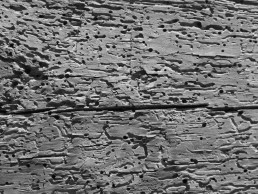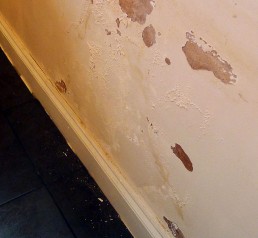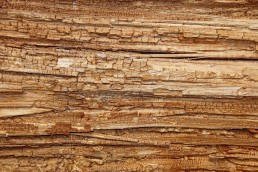How Long Does Woodworm Treatment Last?
Woodworm infestations can cause serious damage to the timbers in your home, wreaking havoc across wooden furniture or burying their way deep into important wooden supports.
Serious structural damage is a major health and safety hazard, so it’s vital to have any woodworm infestation swiftly treated by a professional.
But what does woodworm infestation treatment involve and how long does a treatment last? In this article, we explain how long woodworm treatments take to apply and how long they stay effective.
What Does Woodworm Treatment Involve?
Woodworm is a term that’s used to describe a range of woodworm species that burrow deep into timbers. Woodworm larvae leave behind distinctive trails as they dig their way into timbers searching for cellulose. Eventually, those tiny holes can lead to dangerous structural instability if left untreated.
Woodworm first need to be located and identified by a professional, before a woodworm treatment is selected and applied. Treatments vary depending on the species and the extent of the infestation. If woodworm are only present at surface level, surface sprays or pastes can be used. If the woodworm are deep in the timber, injections need to be applied to reach them.
The treatments are designed to kill existing woodworm in the timber, while also providing an anti-woodworm surface that prevents further infestation. For more details, read this article on how to treat woodworm.
How Long Does Woodworm Treatment Take to Work?
Woodworm treatments work instantly to kill woodworm, and eliminate eggs and larvae in the timbers.
If woodworm are present on the surface, then treatments can be applied quickly and effectively. Depending on the extent of the infestation, the treatment can take just a few hours to be applied throughout the entire household.
If woodworm have burrowed deeper into timbers or are located in less accessible areas of a property, treatment can be more complex but doesn’t ordinarily take longer than a day to be completed (although this depends on the size and extent of the infestation).
So, How Long Does Woodworm Treatment Last?
Woodworm treatments are long lasting and guaranteed to prevent the return of any infestation for years at a time. As strong chemicals, when applied correctly woodworm treatments are able to kill and prevent a return of any woodworm for decades.
In general, woodworm treatments are proven to be effective for 20 years, although in practice this can actually be much longer. The woodworm treatment creates a protective barrier, which prevents new woodworm from taking hold and laying eggs that can hatch into larvae.
For this reason, it’s an excellent idea to not only eliminate woodworm where they are located but to apply treatment throughout a household to stop any opportunity for outbreaks. Remember, prevention is always preferable to treatment when it comes to woodworm!
Get More Information on Woodworm Treatment
For more information and expert advice on treating woodworm in your property, please contact our friendly team on 01765 804050 or fill in our online contact form. Our experienced professionals will be on hand to help you with your woodworm concerns.
What Does a Damp Survey Involve?
Professional surveyors carry out damp surveys in order to identify existing cases of damp within a building. They are often combined with timber inspections to form a damp and timber survey.
These investigations aim to locate potential issues such as wet and dry rot or woodworm infestations, as well as damp.
In this article, we take a look at what a damp and timber survey involves and explain when you might need one.
What Is a Damp Survey?
Damp surveys are independent reports compiled by damp specialists after a thorough inspection of a property.
Carried out as part of a damp and timber survey, the report highlights any structural issues, causes of damp or rot, and more. A standard damp and timber survey aims to identify any of the following:
● Condensation
● Wet and dry rot
● Rising damp
● Penetrating damp
● Woodworm infestations and other pests
A damp and timber survey identifies any existing issues and potential problems that may arise in the future, before providing recommendations for treatment, repair, or prevention.
When Do I Need a Damp and Timber Survey?
If you’re worried that your home’s timbers may be contracting rot or that penetrating damp is getting into the walls, then a damp and timber survey is the best course of action. Damp Surveyors will identify and isolate existing problems, and make recommendations for prevention and repair.
Prospective home buyers or property investors should always have a damp and timber survey carried out before they make a purchase.
In fact, the vast majority of mortgage lenders will ask for a damp survey to be carried out before they loan any money, and surveys are often carried out as part of a wider homebuyer’s survey or building survey.
It’s an excellent way to catch any existing problems, giving you the opportunity to negotiate repairs or better prices with the seller, while ensuring you’re not sprung with hefty repair costs after you’ve made a purchase.
How Long Does a Damp and Timber Survey Take?
The length of time a damp and timber survey takes to be completed depends on the size of the property and the extent of any existing damage.
Other factors include the age of the building and how accessible its timbers are. If floorboards need to be removed, for example, to check for signs of an infestation or hidden damp, then surveys take longer to complete.
In most cases, a thorough damp and timber survey takes no more than a few hours, and it’s rare for a survey to take up a whole day. Once surveyors have collected the data and photographs they need, they compile a report before presenting you with their findings and recommendations at a later date.
Get A Damp and Timber Survey
For an impartial discussion about your damp concern or damp surveys, please contact our friendly team on 01765 804050 or fill in our online contact form. Our experienced damp proofing professionals will be on hand with expert advice tailored to resolve your problem.
Image courtesy: Nick Youngson
How Do You Stop Damp Coming Through Walls?
Damp, moisture and water can all cause unwanted or even dangerous damage to a home when they start penetrating the walls.
Damp damage can lead to mould, wood rot and even the collapse of structural supports within a home or commercial property, so it’s important that your home is kept damp free and damp proof.
In this article, we take a look at the best ways to damp proof your property.
Does Your Property Have a Damp Proof Course (DPC)?
A damp proof course (DPC) is the most effective barrier against rising damp, a form of damp that occurs when water from the outside seeps upwards into the walls of your home.
It’s a protective, waterproof layer that stops damp from rising. Damp proof courses can vary but often consist of a simple plastic layer or a more effective chemical membrane.
Modern homes are required to have a damp proof course, however many older properties might never have had one installed. Damp proof courses can also break or degrade over time, leaving your building defenceless against rising damp.
To protect against damp, you need a DPC and you need it to be working. Luckily, they can be repaired or installed by a professional.
Are There Any Water Leaks?
Leaking water is one of the biggest causes of damp, and it’s often due to faulty or overloaded infrastructure.
Bad plumbing or leaking pipes can quickly lead to dampness in the walls, while blocked drains and gutters can cause water to flood through the roof or external walls.
Check your plumbing is up to scratch and that your pipes aren’t blocked, and you’ll prevent damp from getting into the walls.
Is Your Property Ventilated?
Damp doesn’t just get into a home from the outside; it can also be caused by internal problems. The biggest culprit is often a lack of ventilation.
Poor ventilation causes a build-up of condensation (particularly in areas where hot and cold air meet, such as the kitchen or bathroom). This leads to damp getting into the internal walls of a property, which can then lead to mould or wood rot.
If you’re struggling with condensation, then a simple solution is a dehumidifier. Often, it’s enough just to leave the windows open for longer, too!
Have a Damp Survey Carried Out
It can be difficult isolating the cause of damp in a building, particularly if there’s a problem with the structure or damp proof course.
For this reason, it’s recommended to have a professional damp survey carried out by a specialist. As well as identifying existing problems, they can also provide recommendations for damp proofing the property. After all, preventing damp problems from arising is always preferable to carrying out expensive repairs.
Contact Damp Proofing Specialists in Yorkshire and Teesside
For more information and advice on damp proofing your home or commercial property, then please contact our friendly team on 01765 804050 or fill in our online contact form. Our experienced specialists will be on hand and ready to offer expert advice tailored to resolve your problem.
How to Treat Wood Rot
Wood rot is caused by fungal spores eating their way through wooden timbers, be it wooden furniture, door frames, or even the structural supports holding a building together.
As timbers decay they become increasingly unstable and dangerous, leaving a major health and safety hazard inside your home or commercial property.
So how do you treat wood rot and prevent it from returning? In this article, we explore the best ways to treat wood rot.
What are the different types of wood rot?
There are two distinct types of wood rot that need to be considered before any treatments can be recommended and applied. These are wet rot and dry rot.
Both types of wood rot are caused by fungal spores eating through cellulose found in timbers. Both only occur in wet and damp conditions, as the fungal spores are activated by moisture.
Wet rot requires extremely high levels of moisture to survive, so it’s only found in incredibly damp conditions. Wet rot mostly remains static, but causes large amounts of damage when left untreated.
Dry rot requires much lower moisture levels to thrive, so it can easily spread through a home from one timber to the next. Dry rot can quickly cause damage as it spreads, and needs to be treated rapidly.
What are the signs of Wood Rot?
While wood rot might not be visible on the surface, it could be causing massive amounts of structural decay beneath the timbers.
For this reason, it’s important to be given a proper diagnosis by a professional who can locate and identify different types of wood rot that could be afflicting your home, before recommending the best course of treatment.
If you notice any of the following signs of wood rot, it’s time to call in a specialist.
● Musty or mushroom-like smells
● Growth of mould
● Soft timbers
● Discolouration of timbers
● Visible decay of timbers
● Areas of damp
How to identify and treat wood rot?
The exact treatment depends on the extent of the wood rot, how long it has been spreading for, and the damage that’s already been caused.
The first step is to identify where the rot has taken hold and the type of rot that’s present in the property. While dry rot can be very visible, wet rot is often hidden out of sight.
The most effective method of wood rot treatment is to apply a fungicide or chemical spray. This kills any existing spores and creates a protective anti-fungal layer that stops future fungal spores from establishing themselves on timbers. This only works however if the rot is on the surface.
If the wood rot is below the surface or has already caused extensive damage to important, structural timbers, then the only treatment is to remove the timbers and replace them. This is much costlier and more disruptive, which is why it’s so important to act fast when you suspect the presence of wood rot in your property.
Get in touch with Wood Rot Treatment Specialists
For more information and advice on how to treat wood rot – both wet and dry rot – then please contact our friendly team on 01765 804050 or fill in our online contact form. Our experienced professionals will be ready to offer expert advice tailored to resolve your problem.
What Are Cavity Wall Ties Used For?
Cavity wall ties are the unseen supports holding the walls of a building together. They are an essential yet invisible element of building construction, providing stability and ensuring that walls don’t collapse.
Despite their importance, cavity wall ties are rarely top of maintenance lists for homeowners; most of us don’t even realise they’re there! In this article, we explain what cavity wall ties are and what they are used for.
What are Cavity Wall Ties?
Cavity wall ties are metal strips or metal rods used to connect walls together, providing structural support to walls and to a building as a whole.
Cavity wall ties are placed between the inner and outer walls of a home (the space in between the two layers is called the cavity, and it’s there primarily for insulation). These thin metal rods connect the two layers together, essentially holding them up.
Given how important this sounds, you might be surprised to see just how thin cavity wall ties are. However they’re produced from incredibly strong metal alloys, with steel or zinc being the most common.
Why are Cavity Wall Ties so Important?
It’s always necessary for broken or damaged cavity wall ties to be replaced, because the role they provide is vital to a building.
Cavity wall ties hold the bricks of the two layers of a wall together, allowing the wall to stand as one firm unit rather than two individual sections. This provides an excellent level of structural support for a property as a whole, and stops structural instability or collapses from occurring.
Cavity wall ties also enable better insulation, allowing a building to be managed in an energy-efficient manner. They help to maintain proper ventilation by keeping the cavity wall space supported, which helps to avoid a build-up of moisture or damp between the walls.
What is Cavity Wall Tie Failure?
Homeowners need to look out for broken or damaged cavity wall ties that are the result of cavity wall tie failure.
Cavity wall tie failure can result in broken masonry, loose tiles and, in extreme cases, total collapse of walls. If broken wall ties aren’t replaced, the consequences can even be deadly.
While cavity wall tie failure can be the result of improper installation or poor brickwork, in the vast majority of cases failure is down to corrosion and rusting. Cavity wall ties are metal and therefore prone to corrosion when subjected to water.
This is a natural process. Regardless how well your home is damp-proofed, it can’t be stopped entirely; it can only be delayed. For this reason, it’s good to know what signs might indicate that cavity wall ties need replacing.
If you notice any of the following, contact a professional for a survey. They can identify the extent of the wall tie failures and recommend solutions for replacements.
● Cracks in the mortar caused by an expansion of cavity wall ties.
● Walls bulging outwards as a result of broken cavity wall ties.
Loose brickwork or, in severe cases, a collapse.
Danford Brewer & Ives is a Ripon based company that operates in the North East and specialises in cavity wall tie replacement. For more information and advice on cavity wall ties, please contact our friendly team on 01765 804050 or fill in our online contact form. Our experienced professionals will be on hand and ready to offer expert advice tailored to resolve your problem.





